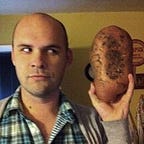The Kindle wink
If you own one of Amazon’s e-readers, there’s a good chance you’ve accessed the “Manage Your Kindle” page at some point.
Do you notice anything strange about that URL? Much of it is just what you’d expect: H-T-T-P colon slash slash server slash something cryptic slash generic word slash verb… except.
What’s fiona? An acronym, perhaps. Functional… Internet-Oriented… Native… Application? File I/O Network Access?
No. It’s not a what but a who, and this is Fiona, her first appearance:
Fiona Hackworth had been wandering through the Royal Ecological Conservatory bracketed by her parents, who hoped that in this way they could keep mud and vegetable debris off her skirts.
A young woman.
A character in The Diamond Age, a science fiction novel written by Neal Stephenson, published in 1995.
A novel set in the medium-flung future, with a plot that hinges on the theft of a kind of super-book.
A super-book that is engrossing, interactive, networked; with pages that change before your eyes; that knows more or less everything. (Again: 1992.)
A science-fictional object that served as the lodestone for Amazon’s efforts, in the early 2000s, to develop an e-reader. In his chronicle of the company, Brad Stone writes: “The early [Kindle] engineers thought of the fictitious textbook in the novel as a template for what they were creating.”
From all this, a codename, Fiona, beloved by those engineers but eventually overwritten by the device’s go-to-market moniker in all places but one.
That URL.
A palimpsest of influence, visible to all Amazon customers who log in to manage their super-book stolen from the pages of science fiction.
A wink to those in the know.
The Kindle isn’t the only piece of technology with these roots, of course—far from it. As I’m writing this, Oculus VR has recently been acquired by Facebook, and in his note announcing the deal, Mark Zuckerberg writes: “Virtual reality was once the dream of science fiction.” These dreams have shaped many of Silicon Valley’s ambitions, but usually, by the time a product emerges functioning into the world, its specific sources have been scrubbed away. Journalists and enthusiasts draw dotted lines, literary inspirations are outlined in oral histories recorded years later, but there’s no sticker on the box: As Imagined by William Gibson!
This elision is not at all inappropriate; there’s a lot of labor between page and product, and it’s not Neal Stephenson and William Gibson toiling in the lab past midnight. It is therefore both charming and charitable to every so often maintain the link.
And, let me tell you: For writers of science fiction and adjacent hybrid genres, it’s also hugely motivating. We often hear about Author X who “predicted the future,” but that’s a hollow achievement, easily accomplished by throwing up a dense screen of possibilities—science-fictional chaff. Prediction just means you saw where the world might be going: ho-hum. Influence, though—ah. Influence, direct and acknowledged, means you actually steered the world, even if only a tiny bit.
A finger on the wheel.
A lodestone pointing the way.
On Amazon’s campus in Seattle, many buildings are named for company concepts and codename. Neal Stephenson visited one.
I love the framing of that photo, with the name—a character but also an idea, synecdoche for a whole science-fictional scenario—floating above its birthplace, the author’s head. That the super-book is now real, and six generations deep, owes mainly to the sustained effort of many people at Amazon and elsewhere. But still: it began with an imaginary girl in an imaginary garden.
May Fiona live on winking in that URL forever.
